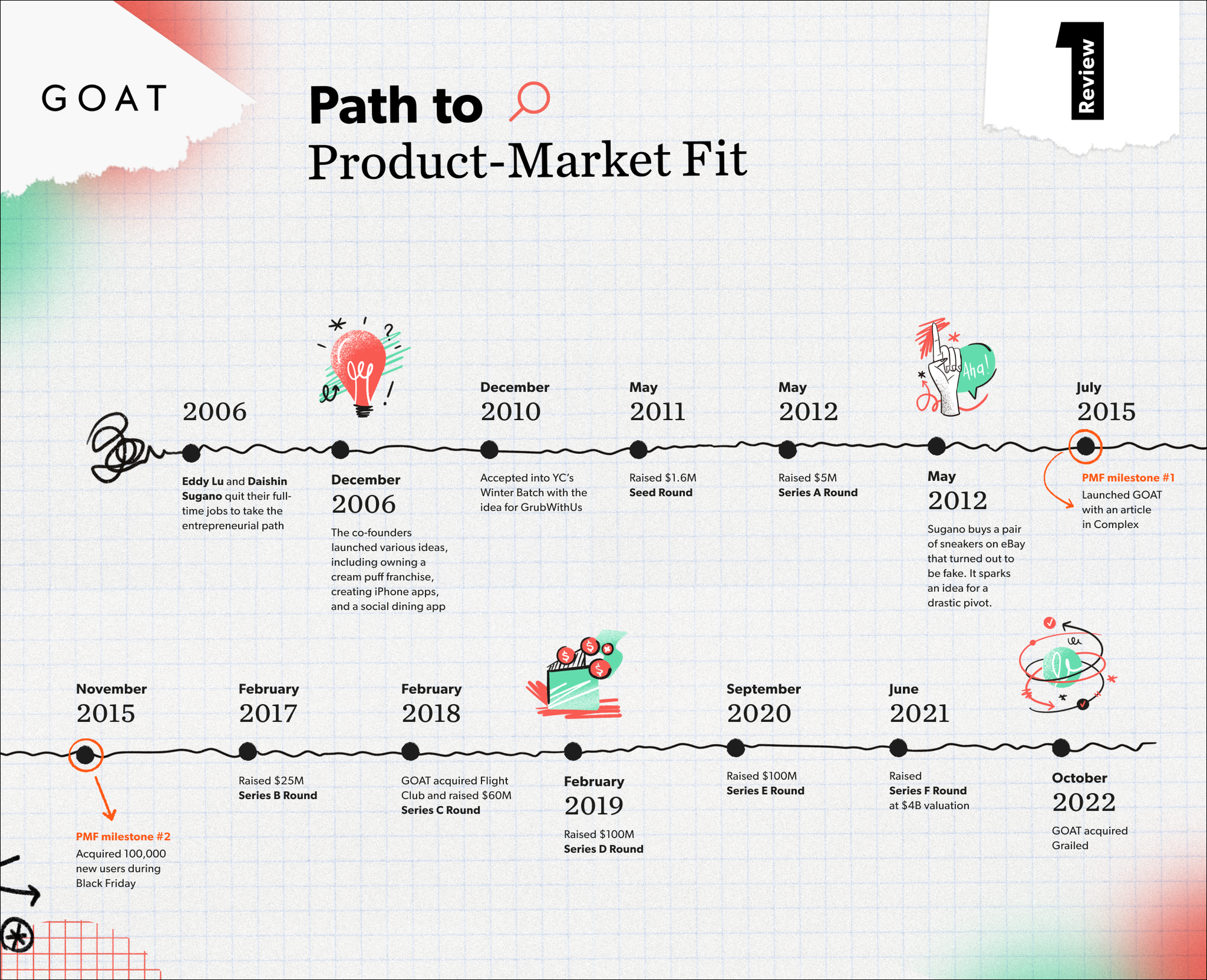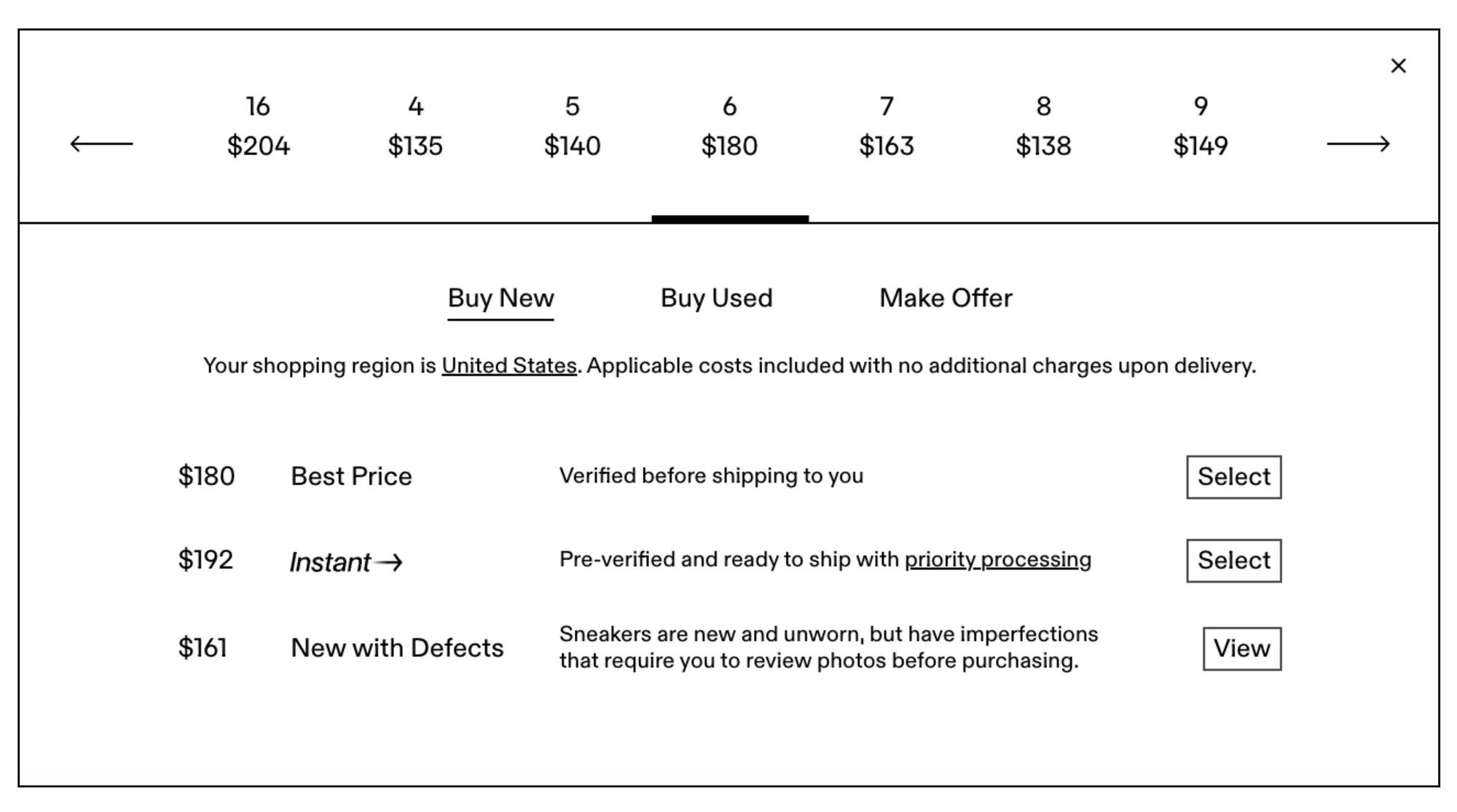No founder’s journey to product-market fit is straightforward — all you have to do is peel back the layers. Even company-building voyages that appear, on the surface, to be relatively linear turn out to be riddled with challenges, from painful pivots to rejections to long stretches of uncertainty.
However, few paths are as winding — and fascinating — as Eddy Lu’s. Today, he’s the co-founder and CEO of GOAT, a global platform for sneakers and luxury apparel that boasts over 350 brands, a million sellers, and 50 million members across 170 countries.
But Lu’s journey to getting where he is today was marked by dozens of inflection points — some that went right, some that went sideways. All of which, when collapsed together, formed GOAT’s enthralling path to product-market fit.
So what exactly happened over the course of the decade it took to build and launch GOAT? Hint: it involved a venture in cream puffs, a pair of fake Air Jordans, and a physical altercation on the basketball court.
To get the full story, we have to rewind to the mid-2000’s.
EXPLORING IDEAS
In 2005, Lu was looking for a roommate in Los Angeles. As it turned out, Daishin Sugano — a friend-of-a-friend Lu had played basketball with a few times — was also on the hunt for a new place to live. They decided to become roommates.
While living together, Lu and Sugano were feeling stagnant and unfulfilled in their corporate jobs and began toying with the idea of teaming up to start a company. “We talked about building something together every single day until, in 2006, we were finally like ‘Hey, we’re not going to figure out how to start a business while working these demanding jobs, so why don’t we just quit?’”
And that’s exactly what they did, kicking off a new era of entrepreneurial endeavors.
Cream puffs
The first venture Lu and Sugano pursued was becoming franchisees for Beard Papa’s — a popular cream puff establishment with a large presence in California. “The plan was to buy a few chains and have a manager run everything,” says Lu.
They opened their first store in 2006, and subsequently two other locations in the couple of years that followed. But after the 2008 financial crisis hit, Lu and Sugano were forced to close two of the three locations.
iPhone apps
In 2008, Apple launched the App Store. Given Lu’s degree in computer science and Sugano’s design background, they figured, why not build a few apps to make some money?
“We developed some of the very first iPhone apps in existence — like to-do lists and simple games that cost $0.99,” says Lu.
While the apps saw moderate success, none of them took off in the way they had hoped.
GrubWithUs
In 2010, Lu and Sugano moved to Chicago to try salvaging and expanding their remaining Beard Papa’s location. As lifelong Californians with few connections to their new city, the transition was tricky for both of them.
“We realized how hard it was to make new friends. That’s when we started thinking: what's an easy way to meet new people?” And that’s how they came up with the idea for GrubWithUs, a social dining app for sharing meals with strangers. Folks could reserve a seat at a table of a participating restaurant, and if four people reserved a seat, the date would be set for the once-strangers to socialize over a shared meal.
With this idea in hand, the co-founders applied to Y Combinator and were accepted in 2011. Soon after, they raised a $1.6 million seed round from a group of investors, (including First Round Capital). A $5 million Series A followed in 2012. But despite the early excitement and an influx of cash, the app just wasn’t taking off.
“Think about all the friction points in that kind of marketplace. People are thinking: What if I’m vegan, and there are no vegan options at the restaurant? What if the restaurant’s too far and people don’t want to travel out of their way? And then there’s the social aspect of having to socialize with strangers. So that social friction, plus all the other friction points, made it impossible for that marketplace to function,” says Lu.

PIVOTING
In an attempt to salvage GrubWithUs, Lu and Sugano knew they needed to pivot. But, as Lu explains, there’s a wrong way and a right way to pivot — as the co-founders, unfortunately, found out the hard way.
The wrong way
“We tried to create a new startup using the existing restaurant data we had. But honestly, we were just trying to save face with our investors. If you had asked us if we were passionate about building this next idea, we would have said no. We were just trying to salvage the scraps that we had,” says Lu.
What makes pivots so pernicious is that it’s easy to get stuck in a vicious cycle of the sunk cost fallacy — you’re loath to let go of everything you’ve worked on, so you end up creating iterations of the same idea that didn’t work in the first place. This is the unenviable cycle that Lu and Sugano found themselves caught in, as their runway continued to shrink.
So the co-founders forged ahead anyway, and ended up wasting months building something they didn’t care deeply about. And sure enough, when the new company finally launched, it failed.
The better way
Amid these panicked attempts to pivot, there was a bit of bad luck that turned into an unexpected lightbulb moment.
“Daishin is a lifelong sneaker enthusiast, and he got his first pair of Jordans when he was 10 years old. In 2013, that same shoe — Air Jordan 5 Grapes — was re-released. So, of course, Daishin went on eBay to snag a pair,” says Lu.
Even though Sugano put hours and hours of research into choosing what seemed like a legitimate eBay seller, he ended up receiving a fake pair. While he was, understandably, pissed off, it sparked a new idea.
It raised a question in our minds: how come, in this day and age, we have hundreds of options for purchasing sneakers online but still have to worry whether something is real or fake?
To Sugano and Lu, it was obvious that there was a need for a sneaker marketplace where everything was authenticated. And that’s how they stumbled upon the idea for GOAT.
Even though they were excited about the kernel of an idea (much more so than their previous venture), Lu and Sugano were nervous about presenting such a dramatic pivot to their investors. They first approached Greg Bettinelli, a partner at Upfront Ventures with a lot of marketplace experience.
After hearing their pitch, Bettinelli was convinced of the new idea and gave Lu and Sugano the green light to drastically change course. So the co-founders got the emotional buoy they needed to email the rest of their investors, who encouraged them to keep their remaining money and go for the pivot. Looking back, Lu says that this approach to pivoting was clearly a better one.
You need passion, a solvable problem, and luck: That’s the equation for pivoting.
BUILDING
At this point, Lu and Sugano only had around $1 million left in runway. So they knew they needed to build and validate their authenticated sneaker marketplace idea, fast.
Based on existing eBay data, they decided their stretch goal should be to sell 100 sneakers per day. But they faced the cold-start problem.
With marketplaces, there's a whole chicken-egg problem. If you have no sellers, there’s nothing for people to buy. With no buyers, sellers don’t want to sell anything on your platform. So we had to hack one side of the equation.
What the co-founders ended up doing was buying a small number of sneakers and putting them up on the platform. But to make it seem like their stock was more robust than it actually was, they had to get a bit creative.
“If you looked at eBay, people were taking pictures of their sneakers on the floor to sell them. So at Home Depot, we went to the flooring section and bought different types of flooring — and then we photographed the same shoes on stone, wood, and laminate,” says Lu.

LAUNCHING
GOAT officially launched in July 2015 with a featured article on Complex. They made 20 sales that day which, while not a hugely impressive number, was still money made — and a milestone to celebrate.
That is until, two weeks later, Lu and Sugano received 11 chargebacks. So instead of making money after launching, they lost money. Sales were sluggish until Black Friday of that same year, which is when things changed drastically.
“Our Head of Marketing wanted to do a Black Friday promo. We only had tens of users at that point, so we were like, ‘Sure, do whatever you want.’ So as a Black Friday event, we decided to discount the hottest sneakers of 2015 to retail prices.”
For a bit of context: sneakers are one of the few marketplace items that tend to increase in Gross Merchandise Value (GMV) over time — and this was the year that the Yeezy line launched. So the fact that GOAT was going to sell sneakers valued at over $600 for the original retail price of $200? That was a big deal in the sneakerhead community, even though the co-founders didn’t quite realize it at the time.
The result? Every single publication in their industry wrote about the promo and, as a result, GOAT had a massive influx of users on Black Friday that crashed their site. They went from having tens of users to over 100,000 in one week.
While this might sound like a dream, it ended up being a nightmare for the co-founders. Between the failing website — and the fact that they actually only had 50 pairs of shoes in stock for the promo — users were deeply upset. So angry that some people directly attacked Lu himself, leaving him nasty comments on social media.
“People had skipped work, school, and even doctor’s appointments to be online for our Black Friday drop, and they were upset when the site crashed. We had to apologize profusely,” says Lu.
What was unusual about GOAT’s predicament was that, while they were certainly in the midst of a crisis, this was also their ‘aha’ moment — the surefire signal that they found product-market fit. But it was difficult to recognize the significance of that moment when people were sending Lu expletive-loaded messages. It was Bettinelli who gave the co-founders the perspective they needed:
In that painful moment, we got advice that I’ll always remember: At our company’s stage, it’s better to be hated than unknown.
Turns out, this mantra was spot-on.
EXPANDING
Despite the thousands of unhappy GOAT users, they stayed. The reason, Lu believes, is because they figured out what GOAT was trying to do — authenticating sneaker purchases — and believed in the idea enough to give them another chance.
So despite the initial hiccups, sales skyrocketed after Black Friday. During their period of hypergrowth, Lu and Sugano made sure to keep all the lessons from their past failed entrepreneurial endeavors top of mind.
PMF Lesson #1: Prioritize reducing friction
One of the most controversial decisions the GOAT team made in the early days was the way they decided to display their products.
Let’s say, for instance, you were searching for a pair of Yeezy Slides in size 6 in the color onyx. On eBay, you would see dozens of listings from different sellers who are selling that exact product. On GOAT, you see the shoe and, below that, the seller who had the best price, fastest shipping time, or a reduced cost due to small defects.

When GOAT rolled out this feature, it caused a big uproar because it changed the way people shopped for sneakers. Lu and Sugano even had some big players in the industry tell them they were making a huge mistake. But they stood firm by their decision, based on what they learned from their time building their last company.
“With GrubWithUs we learned that friction can kill marketplaces. On eBay, you could have 300 sellers who were listing the exact size of shoe you were looking for, and you would have to sort through ratings, comments, shipping information to find exactly what you need. We wanted to remove that friction from the experience. And since we’re an authenticated marketplace, people could trust that they would receive exactly what they ordered,” says Lu.
PMF Lesson #2: Don’t rush
Today, GOAT sells both sneakers and luxury apparel, and the company has a massive international presence with 17 authentication centers around the world — from Malaysia to Berlin. But the process of expanding even from sneakers to apparel took close to five years, says Lu.
“Again, it was because of our painful lessons from GrubWithUs,” Lu says. “Shortly after we launched, we decided to expand to 12 new locations — even though we didn’t have the internal infrastructure or product-market fit — because we knew that any time we opened up in a new city, we were going to see an uptick to gross merchandise value. Instead, we went from having one problem to 12 problems, and then everything fell apart. So with GOAT, we wanted to do it right. We wanted to focus, win in the sneaker industry, and then expand.”
ON COFOUNDER RELATIONSHIPS
While much attention is, rightfully, paid to the process of zeroing in on the idea and building from 0-1, Lu urges founders to pay just as much attention to de-bugging the co-founder relationship. In fact, it’s the reason why many companies fail before they even have a chance to take off.
This isn’t to say that even highly functional co-founder relationships won’t have their fair share of conflict. While he and Sugano have been business partners for over two decades now, he admits that there have been a lot of tense moments. One, in particular, stands out in his mind.
“We went with our friends to go play basketball,” says Lu. “We ended up on opposite teams, guarding each other. As the game went on, we got increasingly physical and aggressive with each other. During one play, I practically picked him up and threw him on the ground.”
This evolved into a full-blown physical altercation, where Lu and Sugano had to be separated by their friends. You might imagine that this would sour the relationship — at least for a little while. But after they got in the car, Lu remembers: “We just looked at each other and were like, ‘OK, let’s get back to work.’”
The lesson being: Even in the strongest co-founder relationships, things will get tough. Emotions run high, stress bubbles over, and you have intense disagreements. But, as Lu explains, you have to be able to put these things behind you and move forward together as a team.
LOOKING FORWARD
With GOAT, Lu and Sugano have completely changed the way people interact with sneaker culture and high-end fashion. And, as evidenced by the fact that they raised their Series F in June of 2021 at a nearly $4 billion valuation, there are no plans to slow down.
The secret, according to Lu, is to have unrelenting grit and an unshakeable belief in yourself. At one point while building GrubWithUs, some investors had even urged Lu and Sugano to find a way to get acquired. It went as far as taking a few meetings with potential companies that might be good landing spots.
“But at one point, we just looked at each other and were like, do we really want to go through with this? Are we burned out? Are we sick of each other? And the answer was no — we weren’t ready to throw in the towel. We wanted to keep going,” says Lu.
